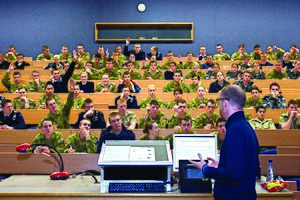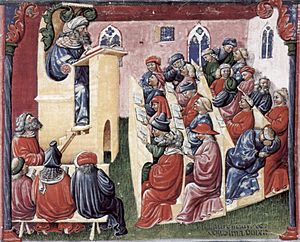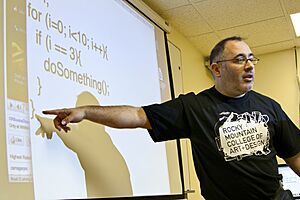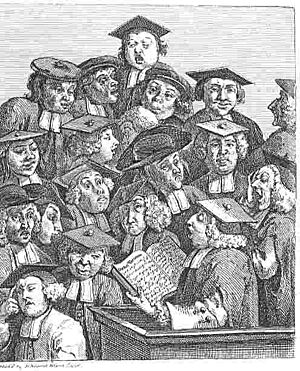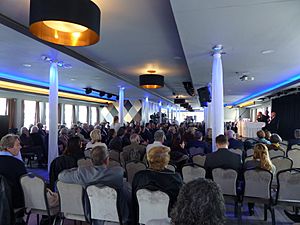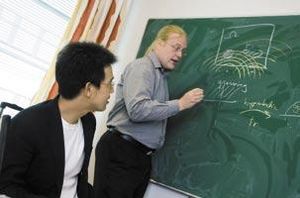Lecture facts for kids
A lecture is a talk given to teach people about a certain subject. It comes from the Latin word lēctūra, meaning "reading." You often hear lectures at universities or colleges, where a teacher shares important information. This can include history, theories, or facts.
Lectures are used to share a lot of information quickly. They help introduce many students to a new topic. While a politician's speech or a religious sermon might seem similar, a lecture's main goal is to teach. Usually, the person giving the lecture, called the lecturer, stands at the front and talks about the topic.
Some people think lectures are not the best way to learn. This is because they are mostly one-way communication. Students usually listen quietly instead of participating much. This is sometimes called "passive learning." However, lectures given by great speakers can be very exciting. They are also a quick and cheap way to teach many students at once.
Lectures are important outside of school too. When people win big academic or science awards, they often give a lecture. Important meetings, called conferences, often start with a main lecture. Public lectures have a long history, especially in science and social movements. Places like community centers, libraries, and museums often host lectures. These talks help share knowledge and continue the tradition of sharing stories and information by speaking.
Contents
What Does "Lecture" Mean?
The word "lecture" has been around since the 1300s. It first meant "the act of reading" or "something that is read." This came from the Latin word legere, which means "to read." By the 1500s, it started to mean "a talk given to an audience for teaching."
The word "lectern" is also related. It means the special stand or desk that lecturers use to hold their notes or books.
How Lectures Started
In medieval universities, teachers would read directly from original books to their students. The students would then write down notes from what they heard. Over time, teachers started reading from their own notes instead of just the original books. For a long time, sharing knowledge through handwritten lecture notes was a key part of university life.
Even in the 1900s, notes from lectures often became very popular. Sometimes, a scholar's lecture notes would even be published as books. Today, lectures often include more than just talking. Teachers might write on a whiteboard, ask questions, or have class discussions.
Modern lectures often use computers and projectors. Programs like Microsoft PowerPoint allow lecturers to show videos, pictures, or websites. This can make lectures more interesting. However, some people think that too many pictures or bullet points can be distracting.
Today, you can also find many short video lectures online. These are often 5 to 15 minutes long. They are used in online courses, like massive open online courses (MOOCs), and on learning platforms like Khan Academy.
Are Lectures Effective?
Many people have studied how well lectures work for learning. One researcher, Bligh, said that lectures show that teachers give knowledge to students who don't have it. He found that lectures are good for sharing information. But they are not the best way to make students think deeply or learn new skills.
Research also shows that people's attention can drop during a lecture. Students often take fewer notes as a lecture goes on. Taking a short break or having a quick group discussion can help students pay attention again.
Some experts believe that lectures can be more interactive. They suggest using tools like audience response systems. These allow students to answer questions anonymously, which can encourage more participation.
Good Things About Lectures
Lectures have several benefits:
- They quickly introduce new topics.
- Teachers have more control over the classroom.
- They can be engaging and help explain course material.
- They are good for teaching large groups of students at once.
- Lecturers can share information that isn't easily found in books.
- A good lecturer can inspire students to learn more about a subject.
Challenges of Lectures
However, lectures also have some challenges:
- Students are often passive listeners, not active participants.
- Communication is mostly one-way, from teacher to student.
- Students need to spend a lot of time outside of class to really understand the material.
- The lecturer needs to be a good speaker to keep students interested.
A common saying about lectures, sometimes linked to Mark Twain, jokes about this:
College is a place where a professor’s lecture notes go straight to the students’ lecture notes, without passing through the brains of either.
Other Ways of Teaching
While lectures are common, some great educators have taught successfully without them.
Many university courses that use lectures also have smaller classes. These might be discussion groups, tutorials, or lab sessions. These smaller groups help students get more involved. Often, these extra sessions are led by graduate students or teaching assistants.
Other ways of teaching include:
- Discussions
- Seminars
- Workshops
- Hands-on activities
- Computer-based learning
- One-on-one tutorials
In schools, teachers usually lead "lessons" instead of lectures.
In the 1800s, "parlor lectures" became popular. Wealthy families would invite famous speakers to give private talks in their homes.
See also
 In Spanish: Clase magistral para niños
In Spanish: Clase magistral para niños


